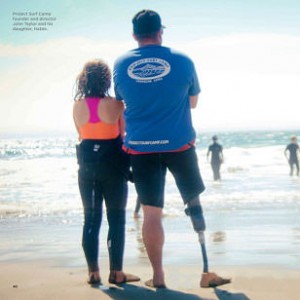- A
- A
- A

This past weekend, I had just shot into the house for a minute, but as I was walking through my foyer, I spotted a big glossy booklet with a picture of a lime green fence, smoking grill and the now-familiar “jcp square” logo in the corner on the pile of mail that had accumulated there. I admit it. I couldn’t resist. I knew I had things to do and was in the middle of a project, but a quick diversion from my chores wouldn’t hurt. I opened it up and immediately saw a picture of a man in a wheelchair hugging a woman wearing a bridal gown and veil, and he wasn’t using the typical hospital-variety wheelchair.
Seriously, this was the first thing I saw.
With just a glance, this looked surprisingly real. That’s because it was. The caption indicated that it was “Real-life father and daughter Robert and BreAuna Velasquez”. I looked closer. This clearly wasn’t one of those dreadful ads with an able-bodied person pretending to have a disability (like the Monroe County public service announcements about accessible parking).
I also checked out the text of the ad, expecting that it would say something dreadful about him not being able to walk her down the aisle.
First love
Sure, you’re spending the rest of your life with the great guy at the end of the aisle. But it all started with the guy who, just like now, has always been by your side. He may be giving you away, but you’ll always be daddy’s girl.
I was stunned. Instead of being schmaltzy and annoying, this was sweet. Instead of a momentary distraction, I was now headed to the living room to read through the book while still wearing my dirty overalls and boots.
As I flip through the ad, it was clear that JCPenney was trying to show the diversity of fathers and their families. Then I see a picture of two men playing with two children. The caption is clear that this is a couple with “their” children. I was sure that was creating a stir, but I was really impressed. The ad seemed to be really well done.
Having flipped through the book backwards, I started going back through the book from front to back. This never happens.
JCPenney didn’t just include one token photo highlighting disability. Later in the ad, there is another page devoted to Project Surf Camp. You notice that John Taylor, pictured with his daughter, has a prosthetic leg. It turns out that John is the founder and director of Project Surf Camp. And although the text about the project does have some medical-model language and talks about having a team of “special  education experts”, it also points out that while striving to “improve self-confidence, social skills, physical fitness and to foster a sense of independence,” the experience is also “just plain fun.”
education experts”, it also points out that while striving to “improve self-confidence, social skills, physical fitness and to foster a sense of independence,” the experience is also “just plain fun.”
The ad doesn’t talk about the impact that John has on young people with disabilities as a role model, but it’s easy to imagine the kind of impact he would have, particularly when they realize he was born with a disability!
Of course, I would appreciate Project Surf Camp. In CDR and RCIL, we have a strong commitment to mentoring young people with disabilities, expanding recreational opportunities for people with disabilities and having “just plain fun”. While surfing isn’t a local option, CDR has even held classes in adapted Scuba. And we are committed to programs that are developed and run by people with disabilities for people with disabilities.
As I look through the glossy pages of ad, I am impressed how JCPenney managed to create an ad that literally stopped me in my tracks so I would read it, but they are doing much more. They are clearly taking on prejudice and helping to change attitudes, including those around disability. I am thrilled that JCPenney is helping to promote social justice, but they may be changing more than that.
For me, the square is now really cool.